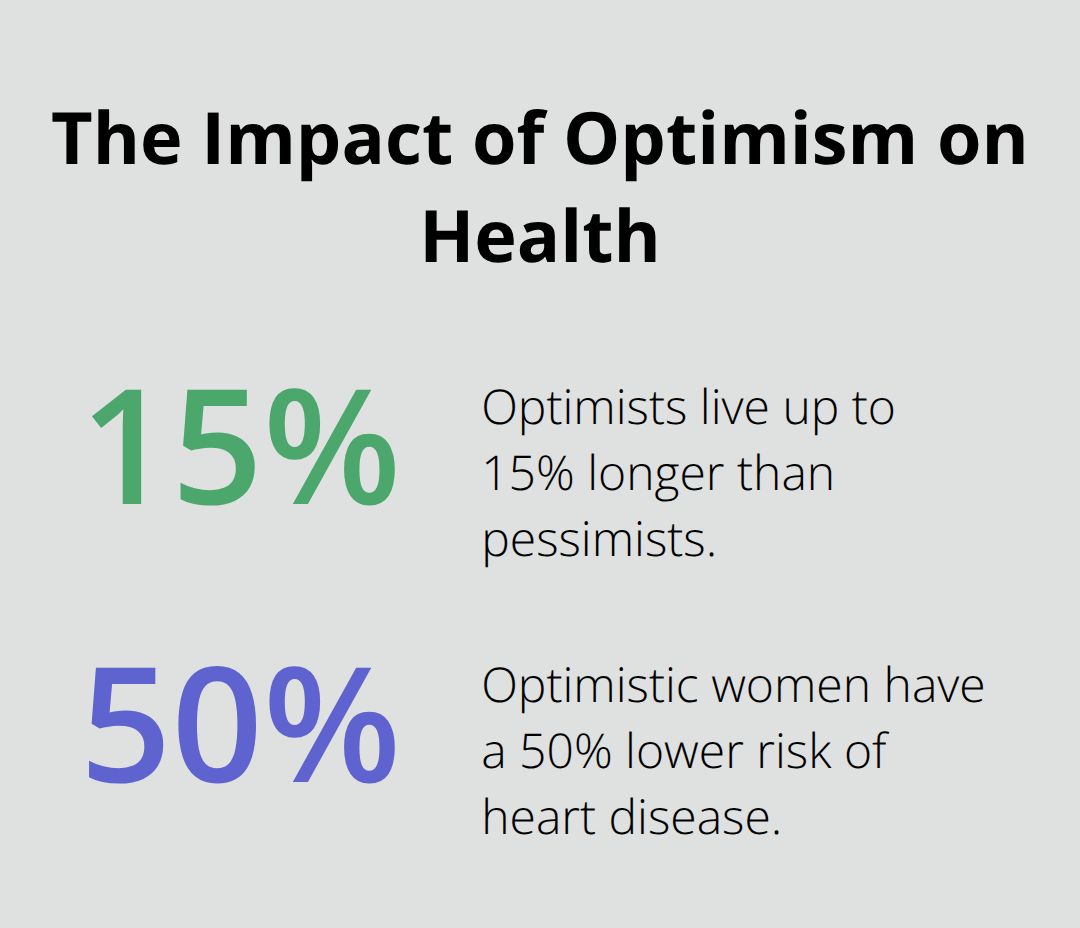Your mindset shapes every aspect of your daily experience. Research shows that people with positive outlooks live longer, experience better health, and build stronger relationships.
Learning how to have a more positive outlook on life isn’t about ignoring reality or forcing fake happiness. We at Global Positive News Network believe it’s about training your brain to notice opportunities, practice gratitude, and bounce back from challenges with proven strategies.
What Does Science Say About Positive Thinking
Your brain physically changes when you practice positive thoughts. The Mayo Clinic confirms that neuroplasticity allows your brain to form new neural pathways throughout your life, which means you can literally rewire negative thought patterns. Harvard researchers found that people who practice gratitude for just 10 weeks show measurable changes in brain structure, particularly in areas linked to attention and sensory processing.
The prefrontal cortex becomes more active when you focus on positive experiences, while the amygdala shows reduced stress responses. This isn’t wishful thinking – brain scans prove that consistent positive practices create permanent structural changes.
Physical Health Transforms With Mental Shifts
Optimists live 11-15% longer than pessimists according to research from Harvard School of Public Health that tracked 70,000 women. The study followed participants for 10 years and found that the most optimistic women had a 50% lower risk of heart disease.

Your immune system strengthens with positive thoughts – optimists produce 50% more antibodies when exposed to flu vaccines compared to pessimists. Forte AJ’s systematic review in 2021 revealed that optimistic cancer patients experience 23% less pain and require fewer pain medications during treatment.
Mental Health Benefits Stack Up Fast
Conversano’s 2010 research demonstrates that optimistic people show 25% fewer symptoms of depression and anxiety disorders. The protective effect works through better coping strategies – optimists use problem-focused approaches rather than avoidance tactics. Hirsch’s 2006 study found that high optimism scores correlate with 40% lower suicidal ideation rates (even in high-risk populations).
Scheier’s research shows optimistic patients report 30% higher quality of life scores after surgery and adapt faster to chronic illness diagnoses. These mental health improvements compound over time and create stronger resilience against future stressors.
Now that you understand the science behind positive thoughts, you need practical strategies to implement these changes in your daily routine.
What Daily Habits Build Lasting Positivity
Start each morning and write down three specific things you appreciate – not generic statements like health, but precise moments like your neighbor’s smile yesterday or the taste of your first coffee sip. Research from UC Davis shows people who keep gratitude journals exercise more regularly and report fewer physical symptoms. The key lies in specificity – your brain responds stronger to concrete details than abstract concepts.
Write about sensory experiences, conversations, or small victories from the previous 24 hours. This practice rewires your reticular activating system to notice positive experiences throughout your day. Keep your journal beside your bed and complete this exercise before you check your phone or start other morning routines.
Transform Stress Through Present-Moment Focus
Dedicate 10 minutes each morning to mindfulness breath work – inhale for 4 counts, hold for 4, exhale for 6. Stanford neuroscientist Andrew Huberman’s research proves this specific pattern activates your parasympathetic nervous system and reduces cortisol within minutes. Download apps like Headspace or Calm for guided sessions, but simple breath awareness works equally well.
Practice the 5-4-3-2-1 technique when negative thoughts arise – identify 5 things you see, 4 you hear, 3 you touch, 2 you smell, 1 you taste. This grounds you immediately and breaks rumination cycles that fuel pessimistic thought patterns.

The technique works because it forces your attention into the present moment rather than past regrets or future worries.
Move Your Body to Boost Mental Resilience
Walk outside for 20 minutes daily – University of Essex research shows natural environments are more beneficial for psychological outcomes like anxiety, fatigue, positive affect, and vigour compared to urban environments. Green spaces reduce cortisol production and increase serotonin synthesis within 15 minutes of exposure (making parks more effective than gyms for mood improvement). Choose trails, parks, or tree-lined streets over treadmills whenever possible.
Schedule these sessions like important meetings because consistency matters more than intensity. People who exercise outdoors report fewer depressive symptoms compared to indoor-only exercisers. Even brief nature walks during lunch breaks create measurable mood improvements that last hours.
Create Positive Social Connections
Reach out to one person daily with a genuine compliment or expression of gratitude. Research shows that people who express appreciation to others experience higher happiness levels and stronger social bonds. Text a friend about something they did well, email a colleague about their helpful contribution, or call a family member to share a positive memory.
These micro-connections compound over time and build a support network that sustains you through difficult periods. Social connections also provide accountability for maintaining positive habits when motivation wanes.
While these daily practices build your foundation, you’ll still encounter negative thought patterns that require specific strategies to overcome.
How Do You Break Negative Thought Cycles
Your mind generates approximately 60,000 thoughts daily, and research shows that 90% of these thoughts are repetitive. The first step requires you to catch these patterns in real-time rather than let them run automatically. Set phone alarms every 2 hours to check your current thoughts – this interruption technique breaks unconscious negative spirals. Cognitive behavioral therapy research demonstrates that people who identify their negative thoughts reduce depressive symptoms by 60% within 8 weeks compared to those who don’t track their thought patterns.
Identify Your Most Common Mental Traps
Three primary negative thought patterns dominate most people’s minds: filtering (focusing only on negatives), personalizing (blaming yourself for everything), and catastrophizing (assuming the worst outcomes). Write down which pattern you use most frequently during your hourly thought checks. Mayo Clinic research shows that people who name their specific negative patterns break them 40% faster than those who try general positive thinking approaches.

Track your patterns for one week without trying to change them. This awareness phase builds the foundation for effective intervention because you cannot fix what you don’t recognize.
Replace Catastrophic Thoughts With Evidence-Based Reality
When you catch yourself thinking the worst will happen, write down three pieces of evidence that contradict this thought. Hirsch’s research shows that people who challenge catastrophic thoughts with factual evidence reduce anxiety symptoms by 45% within one month. Instead of thinking your presentation will be a disaster, list your previous successful presentations, your preparation time, and positive feedback you’ve received.
This technique works because your brain cannot hold two contradictory thoughts simultaneously – facts override fear-based assumptions. Practice this evidence-gathering approach immediately when negative predictions arise (rather than waiting until later when the emotional intensity fades).
Transform Setbacks Into Learning Opportunities
Failed attempts provide information, not personal judgments about your worth. Stanford psychologist Carol Dweck’s research on growth mindset shows that people who view failures as learning opportunities are more willing to embrace challenges and take feedback as learning opportunities. When something goes wrong, ask what specific information this situation provides about your approach rather than question your abilities.
Document what worked, what didn’t, and what you’ll adjust next time. This systematic approach transforms emotional reactions into practical problem-solving sessions that build actual resilience rather than just positive feelings. Keep a setback journal where you record lessons learned from each disappointment.
Final Thoughts
The research proves that positive thinking creates measurable changes in your brain structure, immune function, and longevity. Harvard studies show optimists live 11-15% longer, while UC Davis research confirms gratitude journals improve physical health within weeks. These aren’t temporary mood boosts – they’re permanent neurological adaptations that demonstrate how to have a more positive outlook on life.
Your daily practices compound over months and years. People who maintain gratitude journals, practice mindfulness breath work, and spend time in nature show sustained improvements in depression scores and stress hormone levels. The 5-4-3-2-1 technique and evidence-based thought challenges create lasting resilience against negative thought patterns (which affect 90% of our daily thoughts).
Start with one practice today rather than attempt everything simultaneously. Set hourly phone alarms to track your thoughts, write three specific gratitudes each morning, or take a 20-minute nature walk. We at Global Positive News Network provide uplifting stories and community resources that reinforce your positive mindset journey. Your brain’s neuroplasticity means change remains possible at any age – the science supports your ability to transform your outlook through deliberate practice.




